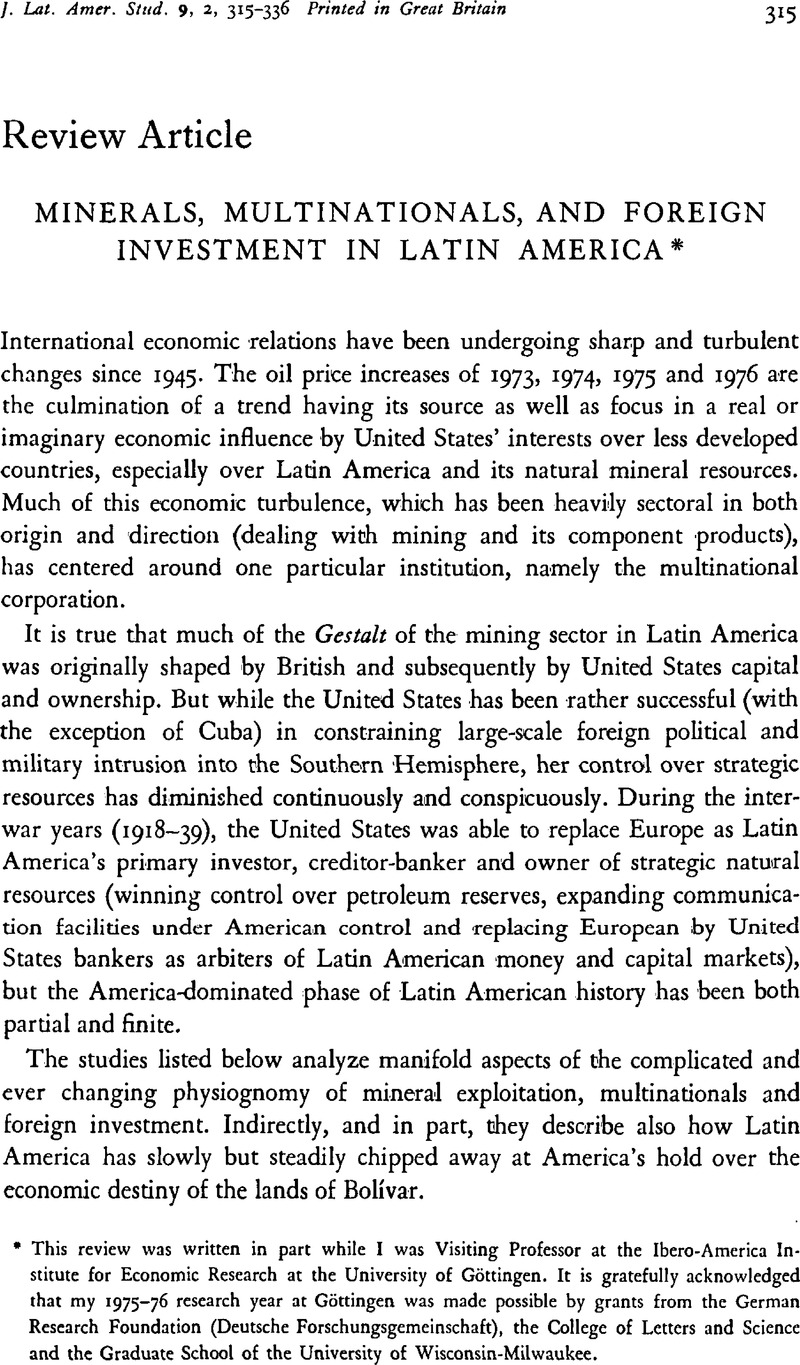Published online by Cambridge University Press: 05 February 2009

1 See Mamalakis, Markos J. ‘The Theory of Sectoral Clashes’ The Latin American Research Review, 6, No. 3 (Fall 1969), 9–46Google Scholar and ‘The Theory of Sectoral Clashes and Coalitions Revisited’ The Latin American Research Review, VI, No. 3 (Fall 1971), 89–126.Google Scholar
2 According to the pioneering work by Raymond Vernon ‘A pronounced change in outlook…occur(s), … after the initial exploration has been completed. The projects that succeed take the limelight. The level of risk associated with the enterprise, as perceived by the parties, drops precipitately…. In less-developed countries… where special provisions generally surround the foreign corporations, the change in perceived risk has a more marked effect. The returns to the foreign company no longer seem appropriate to the risk, and the government feels justified in demanding more out of the project.’ Vernon, Raymond, Sovereignty at Bay, The Multinational Spread of U.S. Enterprises (New York and London: Basic Books, Inc., 1971), p. 48.Google Scholar
3 The high costs, multiple risks and unique bargaining circumstances of oil mining — often forgotten in successful cases such as the Venezuelan – are vividly illustrated in the following excerpts of a recent Wall Street Journal article on Peru: …29 oil companies, most of them based in the U.S., have spent $531 million drilling about seventy wildcat wells in the jungle, with few successes. They are disinclined to throw good money after bad.’ ‘So little oil has been discovered in the jungle that it will take five months just to fill the line with oil so the first trickle can come out the other end. As if that isn't enough, Peruvian officials have seen the cost of the pipeline project triple to $670 million since construction started.’ ‘There still is talk of offering international oil companies new inducements to take another crack at wildcatting in the jungle. “After we've been burned once, I don't know what kind of inducement they can offer us to go back in,” a U.S. oil executive says. But another says, “I think that in five or ten years some one will have a new idea on how to explore that country, and all the companies will come rushing back. You've got to remember they were within a whisker of giving up on the North Sea.’Google ScholarMartin, Everett G., ‘Peru Puzzler:What to Do With Pipeline Built Over the Andes.’ The Wall Street Journal, Wednesday, 12 Jan 1977, pp. 1 and 25.Google Scholar
4 Only Dorothea Mezger makes a crude but effective effort to deal with the unequal risks associated with copper production and processing (concentrating, smelting, refining, fabricating and final use) (Seidman, p. 69). While Mezger divides processing into five phases, copper production is viewed unrealistically as involving one phase.Google Scholar
5 Rising risk-uncertainty of the exploration-drilling phases of new projects can push the overall risk-uncertainty of new projects upward. Old projects, however, can still give the appearance of declining risks because they have entered their low risk and uncertainty phases, thus exaggerating the bargaining power of the host state.Google Scholar
6 As a consequence, there exists ‘project-risk’, ‘-investment’ and ‘-bargaining’; ‘phase- risk’, ‘-investment’ and ‘-bargaining’; and ‘flow-risk’, ‘-investment’ and ‘-bargaining’. While small- and medium-scale mining firms are often involved collectively in flowbargaining, large concerns are more likely to be engaged in all types of bargaining.Google Scholar
7 To the best of my knowledge, the only definitions of international income distribution are found in Mamalakis, Markos, The Growth and Structure of the Chilean Economy: From Independence to Allende. (New Haven and London: Yale University Press, 1976), pp. 228–232.Google Scholar
8 Offsetting capital inflows have been too large to be ignored. See Mamalakis, Markos, ‘Contribution of Copper to Chilean Economic Development, 1920–67: Profile of a Foreign-Owned Export Sector’ in Foreign Investment in Minerals and Petroleum, by Mikesell, Raymond and Associates (Baltimore, Maryland: Johns Hopkins Press for Resources for the Future, 1971), pp. 407–408.Google Scholar